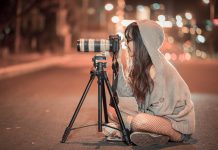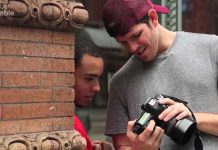Next Challenge: Composing a Sequence
Breakdown of the Beginner’s Sequence
- There are 5 shots, all with the same basic focal length, and held for same length
- All 5 shots are “establishing shots” – showing the scene and the actor. No close-ups.
Breakdown of the Expert’s Sequence
- Start with 2 quick tight shots of the glass and the dog, then the establishing shot.
- Then back to the dog who is reacting to movement.
- We go back and see the movement (getting up)
- Tight walking scene is speed-ramped for just 2 frames to
- Shot of bike and helmet with subject in background
- Sunglasses from side angle going up, then front angle
- Tight ignition shot. Headlight on. Then finale.
- 13 shots. 2.5x faster cuts. 4 wide shots. 9 close-ups.
Your challenge is to frame/compose an action sequence using beautiful shots that also move the story forward. An action sequence can be as simple as getting ready for class, cooking, cleaning, doing homework, etc. A story is full of many action sequences and it can be very difficult to quickly choose what shots are needed to provide the proper context while also keeping a good pace to the story.
As for beautiful shot ideas, consider the following ideas:
- Symmetry
- Rule of Thirds
- Pattern replication
- Shape replication
- Color balanced image
- tracking shot or other gimbal shots
- In-Camera Transitions (whips, covers, etc.)
- Directional Continuity Transition
- Speed Ramp
- Dialogue / over-the-shoulder shots
- Punch-in or Punch-out
- Frame within a frame
- Lines of Convegence or other Lines
- Strategic use of negative space
- Parallax
- Parallax Zoom
So you have to figure out 2 Things:
- What to shoot. (storytelling)
- How to shoot it. (composition, framing, etc.)
What to Shoot
Storytelling when you have little or no control
- Simplify what you think of as a story.
- A story can be as simple as “interesting change”
- Change requires a beginning, middle, and an end. (definition of a simple story)
- Try to find lots of mini-stories and weave them together into a big story.
- GET CLOSER. Work with people and get close. Pull them into the creation process.
- Capture material across the energy spectrum;
- E1: Static shots and landscapes
- E2: Slow-motion with little motion …
- E3; Slow motion of people doing stuff
- E4: Regular Speed
- E5: Laughing, smiling jogging
- E6: Pep, Music, Applause, Cooking
- E7: Dancing, Jumping, Cheering
- E8 Running, Sparring, Leaping
- E9: Screaming, Flames, Speed, Fireworks
- E10: massive explosion, big punch, etc.
- Think about some standard big arcs to put it all together
- Super simple framework: Day in the Life
- Brandon Li’s Formula
- Intro. “The Big Bang” Something Iconic
- Left Turn. Dive deeper with something unexpected.
- Middle Climax. Your 2nd best stuff.
- Interlude. Set up characters for Big Climax
- Big Climax. Best footage. Cross-cutting to weave stories together
- Denouement. Outro. “Soft Landing”
- Finding stuff to shoot when it is out of your control
- ANTICIPATE.
- Look for repetitive actions
- Shoot the most important shots first, then go for more context.
- Consider it like hunting. You find a good spot. Post up. Wait for the shot.
- Use Instagram and forums to find good shots and locations.
Brandon Li’s 80/20 Rule:
80% of what he shoots is crap. 20% gold.
The edit is 80% gold and 20% crap.
Study your gold and shoot more of it.
Note: I shoot about 99.5% crap right now.
The Basics of Composition
3:00 Composition is about focusing the audience’s attention
4:00 Rule of Thirds examples
7:39 Center Framing (there is a technique to it: you need balance)
8:30 Looking room
10:00 short-sighting can say something – breaking rules should be meaningful
10:45 head-room
11:45 Leading Lines
12:15 Repetition
12:39 Golden Ratio
14:00 Use of Contrast
14:20 Frame within a Frame
15:00 Short film with Will Smith example
Angles, Movement, and Storytelling
Inspiration & Guidelines
The Standard Rules (Rule of Thirds, Symmetry, Balance, 180 rule, Headroom etc.)
6 Rules for Video Composition:
- Rule of Thirds: Line up the eyes with the top line.
- Use leading space and reduce negative space
- 180 degree rule: Never cross the line the subjects are on.
- Headroom. Give at least some room (except extreme close-ups)
- Create depth in the image. Shoot 3D not 2D.
- Rules are meant to be broken.
Film with your transitions in mind:
- Pass-by Effect Transition
- Placing additional info in shadows, coats, etc.
- Immersive transitions without establishing shots
- Tilt-shift effect Intro
- Text and messages with different fonts to get inside his head
- Sound is very effective
- Diagetic vs. Non-diagetic
- Frame within a frame
- Spin cuts for passage of time
- Close to characters point of view
- Use of light transitions
- Cut-off cuts
- Bullet Time
- You can understand the story just by listening (sound is that good)
Tips for Quick-Cut Editing (simplify, shape replication, directional continuity, etc.)
- Simplify your shots (center the subject, zoom in, silhouettes)
- Punch in and Punch out.
- Keep the subject moving in the same screen direction
- Follow a dominant shape, color, or luminance
- Establish a cause and effect between shots. (creates a sense of story)
Consider a “Oner” to set the scene:
- Establishing long takes
- Tracking Long take
- Exposition Long take
- Action Long take
- Stationary Long take
- Fake Long Take
Putting Story and Composition Together
0:00 Composition is storytelling. What to show/emphasize and what not to show.
1:45 Composition provides structure and focus to the story
2:18 There are rules that make things pleasing to the eye, but these rules can and should be broken to convey deeper meanings. What can you say when you go against the formula?
3:00 Cinema is still a new art form and has taken many techniques, standards, and assumptions from earlier forms (theater, etc.)
4:15 A language of film slowly emerged: Wide-Angle = Epics, Close-up = Emotion
5:10 1st goal: Get their attention
5:30 Compositional Influencers: frames, lines, light, eyeline, scale, geometry
6:00 Frame within a frame: storytelling possibilities
7:30 Lines of perspective and convergence: Use lines to trap them in a corner, or new paths on a journey
8:46 2nd goal: Which subject has control of the scene
9:13 Artificial vs. Primal Control
9:38 Importance of size and scale in an image
11:45 Or strip away other details and put controller in the middle
12:40 The uses of negative space
13:24 Movement makes composition more challenging, but moving to a new composition can be a great storytelling device
15:00 Every movement creates a new composition – a new piece of art



